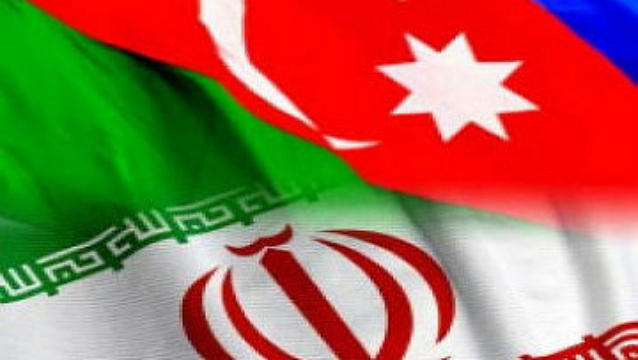Major joint transport projects between Azerbaijan, Iran discussed

By Kamila Aliyeva
Cooperation of Iran and Azerbaijan in transport sector became a central topic for discussion at a meeting of Azerbaijan’s Minister of Transport, Communications and High Technologies Ramin Guluzade and Iranian Minister of Roads and Urban Development Abbas Akhoundi held in Tehran on July 30.
The delegation led by Guluzade is paying a visit to Iran, for participation in the 24th International Exhibition of Electronics, Computer and E-Commerce ELECOMP 2018.
A deal according to which Baku has agreed to allocate a loan worth $500 million for the construction of the Rasht-Astara railway was discussed at a meeting, Iranian media outlets reported.
During the talks held in the Iranian capital, Guluzade and Akhoundi explored ways to speed up the allocation of the loan to the project.
The Iranian minister asked Guluzade to facilitate the financing process and help make the railway operational sooner. He also said the Qazvin-Rasht project is nearing its completion and will be inaugurated soon.
Guluzade, for his part, said that documents with respect to the Rasht-Astara railway are under study at Azerbaijan’s Finance Ministry and “we are hopeful to achieve good results about the financing soon."
Akhoundi also invited Azerbaijan to join a new railway that links the border town of Parsabad in Iran's Ardabil Province to Mugan plain in northwestern Iran and the southern part of Azerbaijan.
He talked about the details of Parsabad-Mugan rail link and invited Baku to join the railway.
“This is an important project similar to Astara-Astara railway between the two countries which can help expand transport cooperation between Iran and Azerbaijan,” the Iranian minister said.
During the meeting, Guluzade also said that Azerbaijan and Iran have agreed to reduce tariffs on interstate cargo transit as part of efforts to activate the International North-South Transport Corridor.
“Iran is keen to activate the International North-South Transport Corridor with the help of Azerbaijan. It has held talks with India and Russia in this regard,” he noted.
The major transit route is designed to facilitate the transportation of goods from Mumbai to Helsinki, using Iranian ports and railroads, which the Islamic Republic plans to connect to those of Azerbaijan and Russia.
He added that transit and customs obstacles need to be removed, noting that the two sides have agreed to facilitate cargo transit between the two neighboring nations.
The Rasht-Astara railroad project will be jointly carried out by Iran and Azerbaijan, each providing 50 percent of the required funding. Azerbaijan will fund $500 million and Iran will invest the same amount in the project.
To complete the railway links of the transportation corridor, Iran had earlier agreed to construct inland railroad segments in northern parts of the country in order to extend its railways to the border area with the neighboring Azerbaijan through the two Astara cities on both sides.
The initial plan included the Qazvin-Rasht and Rasht-Astara railroad segments.
In the meantime, Azerbaijan has launched a construction project to extend its railroads into Iran’s territory, which is going through the final tests and will be implemented soon.
The main goal of strategic cooperation between the railways of Iran and Azerbaijan is activating the International North-South Transportation Corridor which will eventually link Russia and Azerbaijan to High-Seas through the Islamic Republic.
The INSTC, a 7,200 kilometer-long freight route connecting India, Iran, Azerbaijan and Russia via ship, rail and road, is meant to connect Northern Europe with Southeast Asia. The main objective of the INSTC is to provide an alternative to the traditional routes carried out by sea through the Suez Canal and the Mediterranean and the Baltic Sea.
This means goods could be carried from Mumbai to the Iranian port of Bandar Abbas and further to Baku. They could then pass across the Russian border into Astrakhan, then proceeding to Moscow and St. Petersburg, before going in the direction of Europe.
The corridor is expected to bring huge benefits to the Azerbaijani budget. The route enjoys several advantages compared to other transport corridors, as it is considered to be more profitable for each parameter than other alternative routes, including reduction of the distance and delivery time two or threefold.
The route would substantially cut the travel time for everything from Asian consumer goods to Central Eurasia’s natural resources to advanced European exports.
When completed, the INSTC is expected to increase the volume of commodities currently traded between Iran and Azerbaijan from 600,000 tons to 5 million tons per year, dramatically increasing bilateral trade from the current $500 million per year.
---
Kamila Aliyeva is AzerNews’ staff journalist, follow her on Twitter: @Kami_Aliyeva
Follow us on Twitter @AzerNewsAz
Here we are to serve you with news right now. It does not cost much, but worth your attention.
Choose to support open, independent, quality journalism and subscribe on a monthly basis.
By subscribing to our online newspaper, you can have full digital access to all news, analysis, and much more.
You can also follow AzerNEWS on Twitter @AzerNewsAz or Facebook @AzerNewsNewspaper
Thank you!
